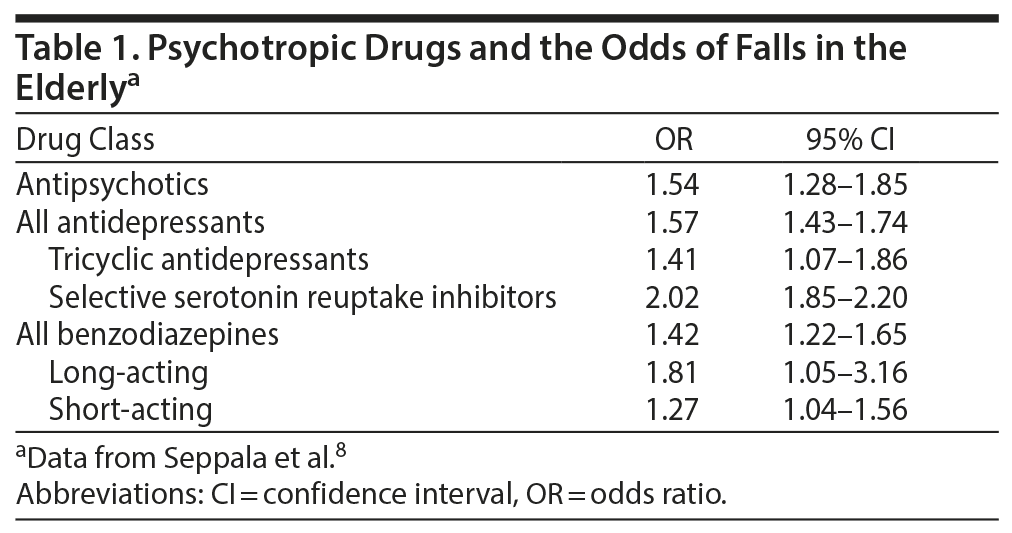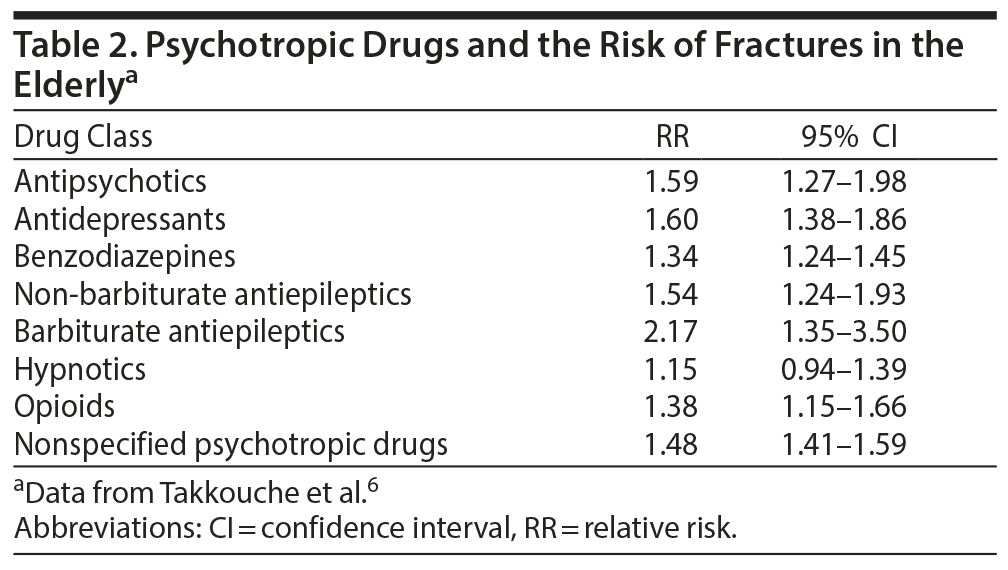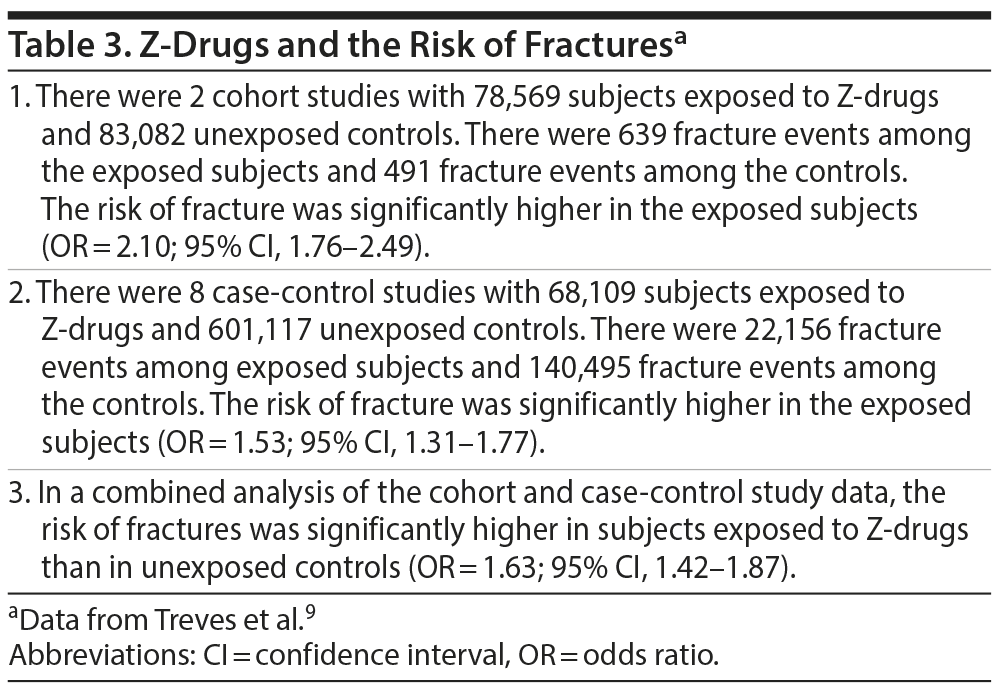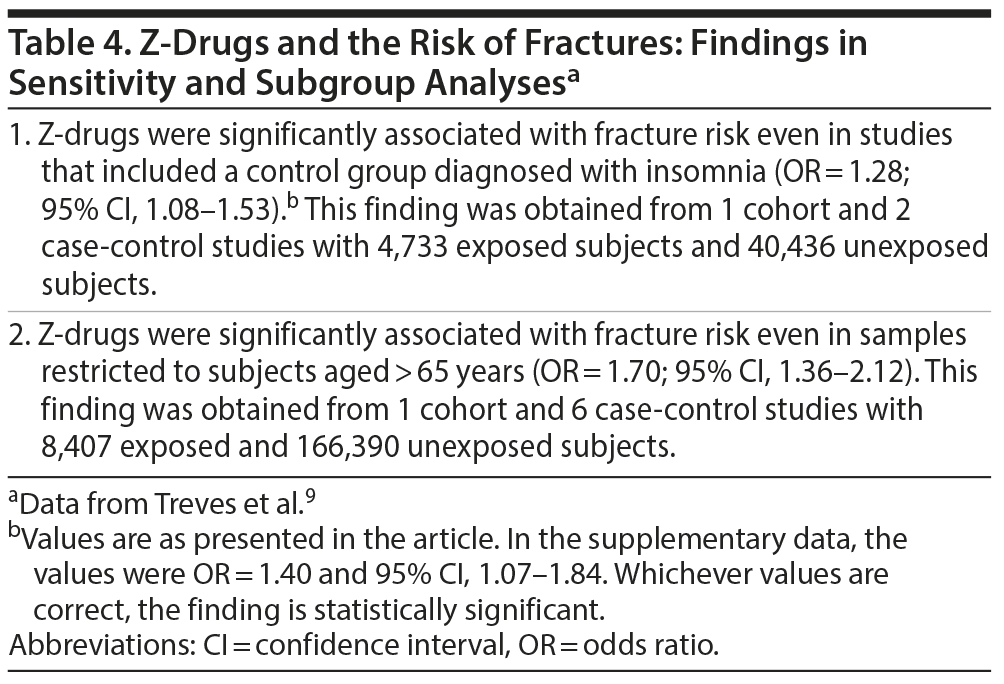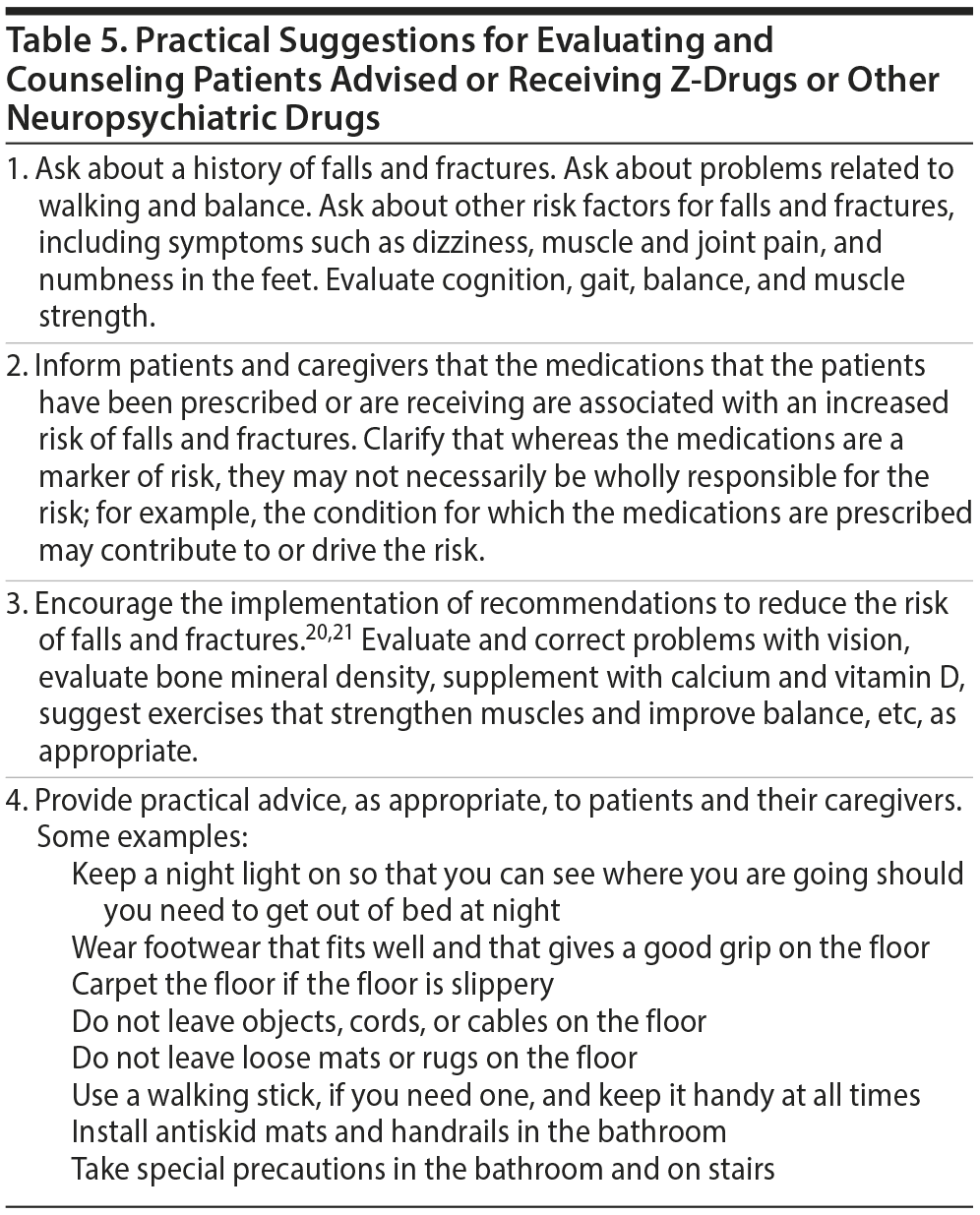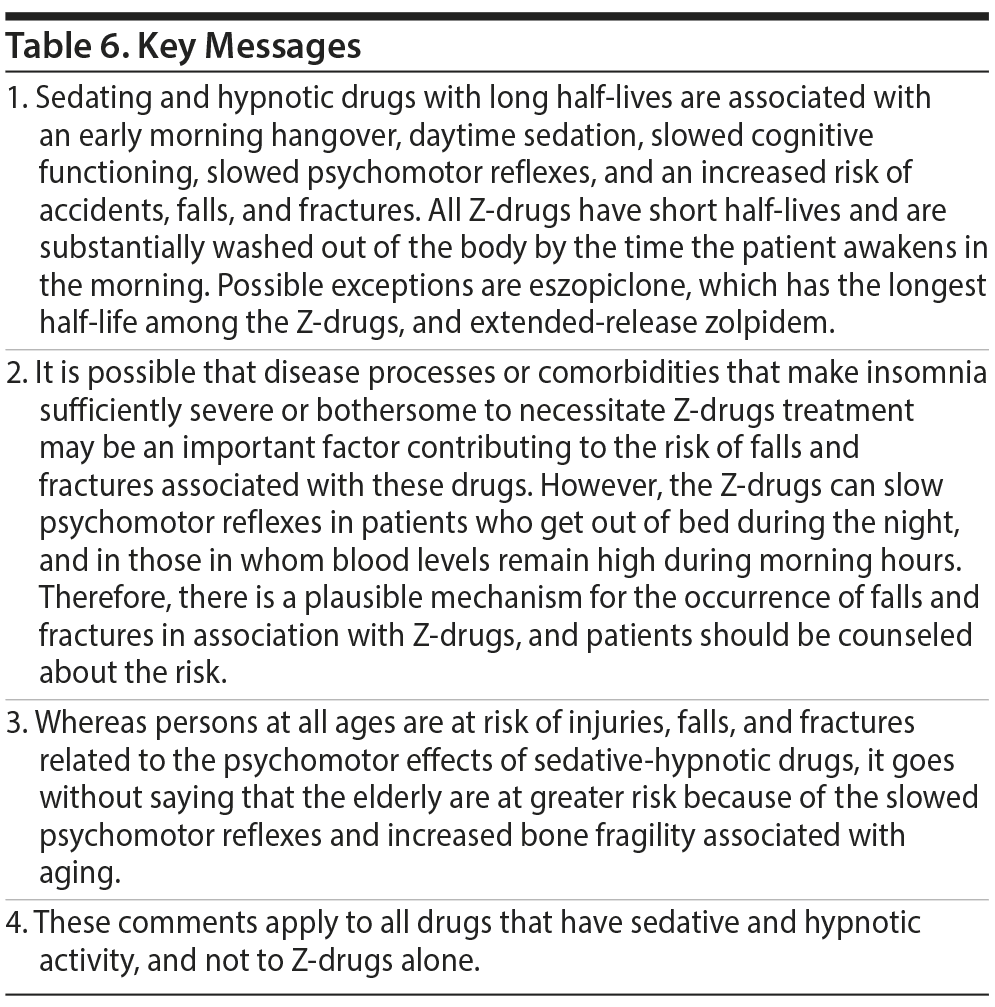Older age, poor sleep, and the use of the "Z" sedative hypnotic drugs (zopiclone, eszopiclone, zolpidem, and zaleplon) commonly go together. Each of these can increase the risk of falls and fractures through mechanisms related to cognitive and psychomotor impairment. A recent systematic review and meta-analysis examined the risk of falls and fractures associated with the use of the Z-drugs. The authors of that meta-analysis identified 14 relevant cohort and case-control studies. They found that Z-drugs increased the risk of falls in 2 out of 3 studies that provided information on this outcome; in the third, the increased risk narrowly missed statistical significance. Z-drugs increased the fracture risk in 9 of 10 studies (odds ratio [OR] = 1.63; 95% confidence interval [CI], 1.42-1.87). In secondary analyses, the fracture risk associated with the use of Z-drugs was elevated in studies that included a control group diagnosed with insomnia (OR = 1.28; 95% CI, 1.08-1.53) as well as in studies of samples restricted to subjects aged > 65 years (OR = 1.70; 95% CI, 1.36-2.12). In 2 studies, zolpidem was associated with an increased risk of injuries. Whereas confounding by indication may explain a part of the risk of falls and fractures, there is reason to consider that Z-drugs augment the risk. Either way, the use of Z-drugs emerges as a clear marker for the risk of falls and fractures. Nonpharmacologic interventions for insomnia should therefore be considered as alternatives to the use of Z-drugs. Finally, patients prescribed Z-drugs and caregivers of these patients should be warned about the risk of falls and fractures and counseled about practical measures that can reduce the risk.


ABSTRACT
Older age, poor sleep, and the use of the "Z" sedative hypnotic drugs (zopiclone, eszopiclone, zolpidem, and zaleplon) commonly go together. Each of these can increase the risk of falls and fractures through mechanisms related to cognitive and psychomotor impairment. A recent systematic review and meta-analysis examined the risk of falls and fractures associated with the use of the Z-drugs. The authors of that meta-analysis identified 14 relevant cohort and case-control studies. They found that Z-drugs increased the risk of falls in 2 out of 3 studies that provided information on this outcome; in the third, the increased risk narrowly missed statistical significance. Z-drugs increased the fracture risk in 9 of 10 studies (odds ratio [OR] = 1.63; 95% confidence interval [CI], 1.42-1.87). In secondary analyses, the fracture risk associated with the use of Z-drugs was elevated in studies that included a control group diagnosed with insomnia (OR = 1.28; 95% CI, 1.08-1.53) as well as in studies of samples restricted to subjects aged > 65 years (OR = 1.70; 95% CI, 1.36-2.12). In 2 studies, zolpidem was associated with an increased risk of injuries. Whereas confounding by indication may explain a part of the risk of falls and fractures, there is reason to consider that Z-drugs augment the risk. Either way, the use of Z-drugs emerges as a clear marker for the risk of falls and fractures. Nonpharmacologic interventions for insomnia should therefore be considered as alternatives to the use of Z-drugs. Finally, patients prescribed Z-drugs and caregivers of these patients should be warned about the risk of falls and fractures and counseled about practical measures that can reduce the risk.
J Clin Psychiatry 2018;79(3):18f12340
To cite: Andrade C. Sedative hypnotics and the risk of falls and fractures in the elderly. J Clin Psychiatry. 2018;79(3):18f12340.
To share: https://doi.org/10.4088/JCP.18f12340
© Copyright 2018 Physicians Postgraduate Press, Inc.
Older age is associated with motor and cognitive slowing and with deficits in coordination; these manifest in many ways, such as in deficits in balance and gait.1 Because of such slowing, an elderly individual could take a fraction of a second longer to make adjustments while walking on an uneven or slippery surface; that fraction of a second could be sufficiently long for the individual to fall. The fall could result in a fracture because of reduced bone mineral density and fragility of bones in the elderly.2
Risk Factors for Falls and Fractures in the Elderly
Difficulties in activities of daily living, and in instrumental activities of daily living, are a marker for the risk of falls.3 Many risk factors have been identified for the fall and fracture risk in the elderly4,5; the use of psychotropic drugs is one such risk factor.6-8
In a systematic review and meta-analysis of 248 studies of the risk of falls in elderly (age 60 years and older) persons receiving psychotropic drugs, antipsychotic, antidepressant, and benzodiazepine drugs were all associated with a significantly increased risk8; the odds of falling associated with different groups and subgroups of drugs are presented in Table 1. In another systematic review and meta-analysis of 98 cohort and case-control studies that assessed the risk of fractures in elderly users of neuropsychiatric drugs, all categories of drugs barring hypnotics were associated with an increased risk of fracture.6 The risks of fracture for different groups of drugs are presented in Table 2. Whereas the indication for which the drug was prescribed could be a contributory reason for the risk, it is reasonable to consider that drug-induced decrease in vigilance as well as psychomotor slowing could also be responsible, or could even primarily be responsible.
Sedative Hypnotic Drugs and the Risk of Falls and Fractures in the Elderly
The lack of association between hypnotic drug use and fractures was from a meta-analysis6 published in 2007. In this context, Treves et al9 published a new systematic review and meta-analysis of the risk of falls and fractures in adults receiving the sedative hypnotic drugs zolpidem, zopiclone, eszopiclone, and zaleplon, collectively referred to as "Z-drugs." This meta-analysis is important because it included many studies conducted in the elderly, because insomnia is common in the elderly, because Z-drugs are commonly used to treat insomnia, and because older age, insomnia, and sedation resulting from the use of Z-drugs may each impair cognition and psychomotor functioning, predisposing to falls and fractures.
Treves et al9 searched electronic databases, clinical trial registries, reference lists, and other sources and identified 14 eligible studies: 2 case-crossover studies, 7 case-control studies, and 5 cohort studies. Three studies reported data on falls, 10 on fractures, and 2 on other injuries.
Fractures. There were 10 studies that reported data on the association between Z-drugs and fractures; 8 studies focused specifically on zolpidem. In these studies, there were 146,678 subjects exposed to Z-drugs and 684,199 unexposed controls. Important findings related to fractures are presented in Table 3. In summary, in all but 1 of the 10 studies, Z-drugs were associated with a significantly higher fracture risk. In meta-analysis, Z-drugs were associated with a significantly higher fracture risk in the 2 cohort studies, in the 8 case-control studies, and in the 10 studies combined. There was substantial heterogeneity in the analyses, but even when studies contributing to the heterogeneity were removed, the association between Z-drugs and fractures was statistically significant.
The authors9 described subgroup and sensitivity analyses. Zolpidem (odds ratio [OR] = 1.39; 95% confidence interval [CI], 1.15-1.67) and the group of other Z-drugs (OR = 1.63; 95% CI, 1.01-2.62) were each found to be associated with a significantly increased risk of fractures. In what should have been an important part of the primary analysis, studies that included a control group diagnosed with insomnia and studies in samples restricted to subjects aged > 65 years also showed a significant association between Z-drugs and fractures (Table 4).
The association between Z-drugs and fractures was significant in both hospitalized and community samples. Finally, the association with fractures was significant in studies rated as low quality as well as in those rated as high quality. There was no evidence of publication bias based on visual inspection of a funnel plot.
Falls. There were 2 cohort studies and 1 case-control study that reported data on the association between Z-drugs and the risk of falls. In these studies, 5,269 subjects had been exposed to Z-drugs and 14,235 had not been so exposed. Two of these studies found a significantly increased risk associated with Z-drug exposure, and the third found an increased risk that narrowly missed statistical significance. Logically, therefore, one might reasonably interpret these findings to indicate that Z-drugs are associated with an increased risk of falls. However, the case-control study was small and the confidence interval was wide, and the cohort studies were large and had narrow confidence intervals, but there was very substantial heterogeneity in their outcomes. As a result, the summary odds ratio in the meta-analysis was not significant (OR = 2.40; 95% CI, 0.92-6.27). This analysis was also associated with substantial heterogeneity. Therefore, it may be prudent to consider the studies as individual studies rather than summarized in meta-analysis.
Injuries. Two studies examined the risk of injuries associated with exposure to zolpidem. In these studies, 78,322 subjects had been exposed to zolpidem and 82,180 had not been so exposed. Zolpidem was associated with an increased risk of injuries (OR = 2.05; 95% CI, 1.95-2.15). There was no heterogeneity in this analysis.
Comments: Confounding by Indication
Z-drugs are prescribed for patients with insomnia. Insomnia could be secondary to medical or neuropsychiatric conditions, and these conditions may be associated with physical and mental impairments that impair vigilance, balance, posture, and gait. Additionally, patients with insomnia, even primary insomnia, could feel dull, tired, slow, and listless because of poor sleep. Therefore, sleep deprivation, or whatever condition is responsible for the sleep deprivation, could induce the cognitive and psychomotor deficits that predispose to falls and fractures. In other words, confounding by indication may explain the observed association between Z-drugs and falls and fractures. As an example, 1 case-control study10 found that whereas current use (last use within 1 year) of anxiolytics and sedatives was associated with an increased risk of fractures, past use (last use > 1 year ago) was also associated with an increased risk. This suggests that it could be the individual that (also) carries the risk rather than the drug alone.
As a counter argument, the meta-analysis9 found a significant association between Z-drugs and fractures even in studies that had patients with insomnia as controls (Table 4). The authors of the meta-analysis9 further pointed out that the individual studies in the meta-analysis had made attempts to control for confounds by including covariates in their analyses. As an example, in a retrospective cohort study, Kolla et al11 examined data of adult inpatients in a tertiary care center. They found that the rate of falls was 3.0% in 4,962 patients who were prescribed and received zolpidem; this figure was only 0.7% in 11,358 patients who were prescribed zolpidem but did not receive the drug (P < .001). The association between zolpidem use and fall risk remained significant after adjusting for potential confounders, including age, gender, insomnia, presence of delirium, zolpidem dose, Charlson Comorbidity Index, risk score for falls, duration of hospital stay, presence of visual impairment, presence of abnormalities in gait, and cognitive impairment or dementia (OR = 4.37; 95% CI, 3.34-5.76).
Confounding by indication and confounding due to other variables are eliminated in randomized controlled trials (RCTs). However, falls and fractures are infrequent events, and so RCTs, which are limited in sample size and study duration, would be underpowered to detect differences in risk between treated and control groups; in fact, even meta-analysis of RCTs could be underpowered in this regard. For example, a retrospective population cohort study found that the risk of hip fracture in 6,978 zolpidem users versus 27,848 nonusers was only 3.1 versus 1.4 per 1,000 person years.12 This may explain why a meta-analysis of 24 RCTs of sedative hypnotics in 2,417 subjects identified only 7 serious psychomotor adverse events: 6 falls (including 3 fractures) and 1 motor vehicle crash.13
Injuries, however, are more common events. For example, in a retrospective cohort study, Chung et al14 found that the incidence rate of soft tissue, orthopedic, or other injury was 6.1% versus 3.0% in zolpidem-exposed (n = 77,036) versus unexposed (n = 77,036) subjects who were followed up for 90 days. This incidence was 4.8% in 36,528 subjects who had been prescribed zolpidem for < 30 days and 7.2% in those who had received the drug for > 30 days. However, despite the association between longer exposure and higher risk, confounding by indication cannot be ruled out as an explanation for the findings because whatever explains the longer use of zolpidem may also be responsible for the higher fracture risk.
Other recent meta-analyses have also found a significant association between benzodiazepines, Z-drugs, and the risk of fractures, especially at the hip.15,16 Perhaps the best way to view the matter is to consider that, whether or not Z-drugs are causal for falls and fracture risks, their use is a marker for these risks and for the risk of injuries in general. Therefore, all patients who are receiving or are advised Z-drugs need to take precautions as discussed in a later section.
Other Comments
Control subjects in the meta-analysis by Treves et al9 were not necessarily medication-free. Thus, some or many may have been taking psychotropic drugs, including benzodiazepines, that might have increased the risk of falls, thereby narrowing the differences in the Z-drug and control group comparisons. This implies that the effect sizes of Z-drugs on the falls and fractures risks could be larger than what was estimated in the meta-analysis.
There is need in future studies to better identify predictors of risk. Examples of potential predictors include age, sex, osteoporosis, and medical and neuropsychiatric comorbidities.
Action Points
Patients with insomnia do not necessarily need to receive Z-drugs. In many cases, behavioral interventions may be of considerable short- and long-term benefit. Readers are referred to the appendix of the article by Sharma and Andrade17 for practical suggestions for nonpharmacological and behavioral interventions for patients with insomnia.
Many interventions have been studied for the prevention of falls in elderly persons in hospitals, in care facilities, and in the community.18,19 Recommendations have been issued for the prevention of falls and fractures in the elderly.20,21 However, these are long-term interventions and would serve little purpose if initiated at the time of initiation of treatment with Z-drugs. Therefore, in patients for whom Z-drugs are inevitable, more immediate and commonsense, practical advice should be provided (Table 5). Key messages are stated in Table 6.
Because most or all psychotropic drugs are markers for an increased risk of falls and fractures in the elderly, the suggestions provided here apply to all elderly subjects who are started on treatment with psychotropic drugs or who are already receiving psychotropic drugs.
Parting Note
Readers take authors on trust when data are reported and results of analyses are presented. In their meta-analyses, Treves et al9 showed that a case-crossover study22 had found an increased odds of fractures associated with zolpidem use (OR = 1.12; 95% CI, 1.01-1.24). However, the study22 actually showed that, after adjusting for comorbid conditions, zolpidem use was not associated with fracture risk; this was also the conclusion presented in the abstract and in the text. Additionally, the numbers cited by Treves et al9 for this study are not found anywhere in the text of the study. Therefore, Treves et al9 either selectively extracted data from the study to drive the findings of the meta-analysis in a desired direction or made mistakes in data extraction. Either way, one is tempted to wonder how many other problematic issues such as this the meta-analysis may contain.
Published online: May 22, 2018.
 Each month in his online column, Dr Andrade considers theoretical and practical ideas in clinical psychopharmacology with a view to update the knowledge and skills of medical practitioners who treat patients with psychiatric conditions.
Each month in his online column, Dr Andrade considers theoretical and practical ideas in clinical psychopharmacology with a view to update the knowledge and skills of medical practitioners who treat patients with psychiatric conditions.
Department of Clinical Psychopharmacology and Neurotoxicology, National Institute of Mental Health and Neurosciences, Bangalore, India ([email protected]).
Financial disclosure and more about Dr Andrade.
REFERENCES
1. Seidler RD, Bernard JA, Burutolu TB, et al. Motor control and aging: links to age-related brain structural, functional, and biochemical effects. Neurosci Biobehav Rev. 2010;34(5):721-733. PubMed CrossRef
2. Marshall D, Johnell O, Wedel H. Meta-analysis of how well measures of bone mineral density predict occurrence of osteoporotic fractures. BMJ. 1996;312(7041):1254-1259. PubMed CrossRef
3. Bloch F, Thibaud M, Dugué B, et al. Episodes of falling among elderly people: a systematic review and meta-analysis of social and demographic pre-disposing characteristics. Clinics (Sao Paulo). 2010;65(9):895-903. PubMed CrossRef
4. Berry SD, Miller RR. Falls: epidemiology, pathophysiology, and relationship to fracture. Curr Osteoporos Rep. 2008;6(4):149-154. PubMed CrossRef
5. Drake MT, Murad MH, Mauck KF, et al. Clinical review: risk factors for low bone mass-related fractures in men: a systematic review and meta-analysis. J Clin Endocrinol Metab. 2012;97(6):1861-1870. PubMed CrossRef
6. Takkouche B, Montes-Mart×nez A, Gill SS, et al. Psychotropic medications and the risk of fracture: a meta-analysis. Drug Saf. 2007;30(2):171-184. PubMed CrossRef
7. Johnell K, Jonasdottir Bergman G, Fastbom J, et al. Psychotropic drugs and the risk of fall injuries, hospitalisations and mortality among older adults. Int J Geriatr Psychiatry. 2017;32(4):414-420. PubMed CrossRef
8. Seppala LJ, Wermelink AMAT, de Vries M, et al; EUGMS Task and Finish Group on Fall-Risk-Increasing Drugs. Fall-risk-increasing drugs: a systematic review and meta-analysis, II: psychotropics. J Am Med Dir Assoc. 2018;19(4):371.e11-371.e17. PubMed CrossRef
9. Treves N, Perlman A, Kolenberg Geron L, et al. Z-drugs and risk for falls and fractures in older adults: a systematic review and meta-analysis. Age Ageing. 2018;47(2):201-208. PubMed CrossRef
10. Vestergaard P, Rejnmark L, Mosekilde L. Anxiolytics and sedatives and risk of fractures: effects of half-life. Calcif Tissue Int. 2008;82(1):34-43. PubMed CrossRef
11. Kolla BP, Lovely JK, Mansukhani MP, et al. Zolpidem is independently associated with increased risk of inpatient falls. J Hosp Med. 2013;8(1):1-6. PubMed CrossRef
12. Lin FY, Chen PC, Liao CH, et al. Retrospective population cohort study on hip fracture risk associated with zolpidem medication. Sleep. 2014;37(4):673-679. PubMed CrossRef
13. Glass J, Lanct×´t KL, Herrmann N, et al. Sedative hypnotics in older people with insomnia: meta-analysis of risks and benefits. BMJ. 2005;331(7526):1169. PubMed CrossRef
14. Chung SD, Lin CC, Wang LH, et al. Zolpidem use and the risk of injury: a population-based follow-up study. PLoS One. 2013;8(6):e67459. PubMed CrossRef
15. Park SM, Ryu J, Lee DR, et al. Zolpidem use and risk of fractures: a systematic review and meta-analysis. Osteoporos Int. 2016;27(10):2935-2944. PubMed CrossRef
16. Donnelly K, Bracchi R, Hewitt J, et al. Benzodiazepines, Z-drugs and the risk of hip fracture: a systematic review and meta-analysis. PLoS One. 2017;12(4):e0174730. PubMed CrossRef
17. Sharma MP, Andrade C. Behavioral interventions for insomnia: theory and practice. Indian J Psychiatry. 2012;54(4):359-366. PubMed CrossRef
18. Cameron ID, Gillespie LD, Robertson MC, et al. Interventions for preventing falls in older people in care facilities and hospitals. Cochrane Database Syst Rev. 2012;12:CD005465. PubMed
19. Gillespie LD, Robertson MC, Gillespie WJ, et al. Interventions for preventing falls in older people living in the community. Cochrane Database Syst Rev. 2012;(9):CD007146. PubMed
20. Grossman DC, Curry SJ, Owens DK, et al; US Preventive Services Task Force. Interventions to prevent falls in community-dwelling older adults: US Preventive Services Task Force Recommendation Statement. JAMA. 2018;319(16):1696-1704. PubMed CrossRef
21. Grossman DC, Curry SJ, Owens DK, et al; US Preventive Services Task Force. Vitamin D, calcium, or combined supplementation for the primary prevention of fractures in community-dwelling adults: US Preventive Services Task Force Recommendation Statement. JAMA. 2018;319(15):1592-1599. PubMed CrossRef
22. Tang YJ, Ho SY, Chu FY, et al. Is zolpidem associated with increased risk of fractures in the elderly with sleep disorders? a nationwide case cross-over study in Taiwan. PLoS One. 2015;10(12):e0146030. PubMed CrossRef
Save
Cite
Advertisement
GAM ID: sidebar-top
